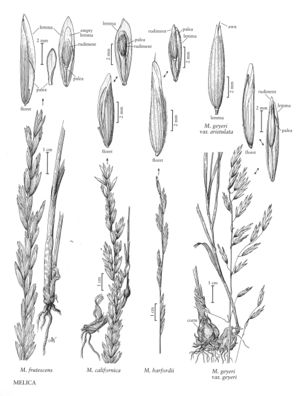Difference between revisions of "Melica californica"
imported>Volume Importer |
imported>Volume Importer |
||
| Line 43: | Line 43: | ||
|publication year= | |publication year= | ||
|special status=Endemic | |special status=Endemic | ||
| − | |source xml=https:// | + | |source xml=https://bitbucket.org/aafc-mbb/fna-data-curation/src/2e0870ddd59836b60bcf96646a41e87ea5a5943a/coarse_grained_fna_xml/V24/V24_111.xml |
|subfamily=Poaceae subfam. Pooideae | |subfamily=Poaceae subfam. Pooideae | ||
|tribe=Poaceae tribe Meliceae | |tribe=Poaceae tribe Meliceae | ||
Revision as of 20:48, 5 November 2020
Plants densely cespitose, not rhizomatous. Culms 50-130 cm, not forming corms; lower nodes strigose; internodes usually smooth, sometimes puberulent below the nodes, lower 2-3 internodes usually swollen. Sheaths glabrous or pilose; ligules 1.5-4 mm; blades 1.5-5 mm wide, strigose on both surfaces. Panicles 4-30 cm; branches 3-6 cm, appressed, straight, with 4-15 spikelets; pedicels straight; disarticulation above the glumes. Spikelets 5-15 mm, with 2-5 bisexual florets; rachilla internodes 1.1-1.6 mm. Lower glumes 3.5-12 mm long, 2.5-3 mm wide, 3-5-veined; upper glumes 5-13 mm long, 2-2.5 mm wide, 5-7-veined; lemmas 5-9 mm, glabrous, smooth to scabrous, 7-9-veined, veins inconspicuous, apices rounded to broadly acute, unawned; paleas about 3/4 the length of the lemmas; anthers 3, 1.8-3 mm; rudiments 1.4-3 mm, clublike, not resembling the bisexual florets, truncate to acute. 2n= 18.
Discussion
Melica californica grows from sea level to 2100 m, in a wide range of habitats, from dry, rocky, exposed hillsides to moist woods. Its range extends from Oregon to California. It differs from M. bulbosa in its more obtuse spikelets and less strongly colored lemmas, as well as in not having corms.
Melica californica var. nevadensis Boyle supposedly differs from var. californica in having shorter spikelets (averaging 8, rather than 10, mm), more acute glumes and lemmas, blunter rudiments, and in being restricted to the lower Sierra Nevada; the two varieties intergrade, both morphologically and geographically.
Boyle (1945) obtained vigorous sterile hybrids from crosses between M. californica and M. imperfecta, but found no natural hybrids.
Selected References
None.
